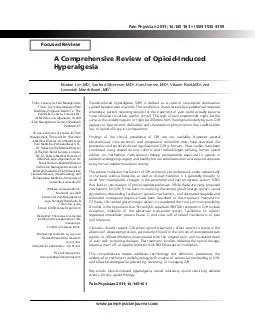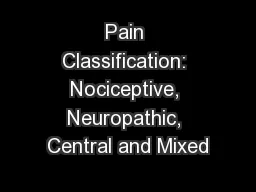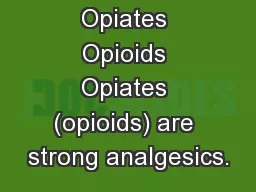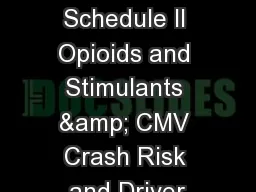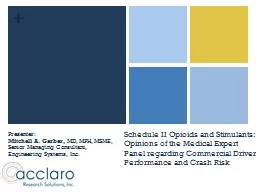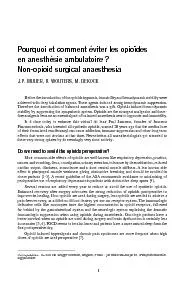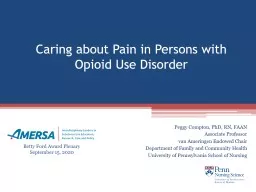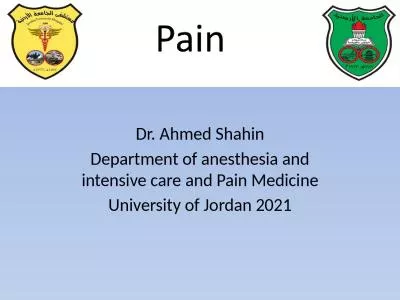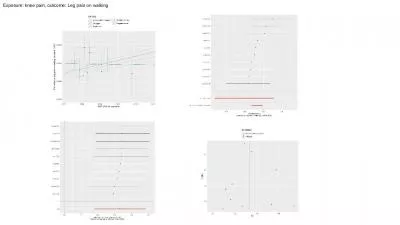PDF-Opioidinduced hyperalgesia OIH is defined as a state of nociceptive sensitization caused
Author : briana-ranney | Published Date : 2014-12-16
The condition is characterized by a paradoxical response whereby a patient receiving opioids for the treatment of pain could actually become more sensitive to certain
Presentation Embed Code
Download Presentation
Download Presentation The PPT/PDF document "Opioidinduced hyperalgesia OIH is define..." is the property of its rightful owner. Permission is granted to download and print the materials on this website for personal, non-commercial use only, and to display it on your personal computer provided you do not modify the materials and that you retain all copyright notices contained in the materials. By downloading content from our website, you accept the terms of this agreement.
Opioidinduced hyperalgesia OIH is defined as a state of nociceptive sensitization caused: Transcript
The condition is characterized by a paradoxical response whereby a patient receiving opioids for the treatment of pain could actually become more sensitive to certain painful stimuli The type of pain experienced might be the same as the underlying p. Identifying . indicators of good prescribing and problem use in . primary care. Nicola . Torrance. Research Fellow. Chronic Pain Research . Group. http. ://medicine.dundee.ac.uk/chronic-pain. . Adverse effects. Spo Kgalamono. WRA is common. Most common OLD in high income countries. Recent evidence - WRA accounts for up to 1 in 4 new cases (25%) of adult asthma ( a 4-fold increase in 3 decades). Now . probably. Presentation provided by. Meldon. . Kahan. , MD. Family & Community Medicine. University of . T. oronto. CSAM-SCAM Fundamentals. Conflict of interest statement. Dr. Christy Sutherland . -. none. Rachael Rzasa Lynn, MD. Chronic Pain Zoom Webinar. 2 December 2015. Definitions. Most basic = neurophysiologic classification. based . on . presumed mechanism . of pain. . Simplified, there are 2 types of pain:. Emerging knowledge and clinical experience. Conflict of Interest. None to declare. Objectives. Brief . overview of areas of emerging knowledge . F. acilitated discussion of clinical experiences and evolution . Opiates bind to receptors in the brain, which means that they kill pain by preventing the transmission of pain impulses in the brain, rather than at the source.. Opiates are derived from opium, which is found in poppy seeds. . Performance: . A Review of Findings for the Medical . Review Board. July . 29, . 2014. Roadmap. Purpose. Background. Overview of Research Questions . Search Methodology . Q1a . Q1b . Q2 . Q3 . Conclusion. Stimulants: . Opinions . of the Medical . Expert Panel regarding Commercial Driver Performance and Crash Risk. Presenter: . Mitchell A. . Garber,. MD, MPH, MSME, Senior Managing Consultant, Engineering Systems, Inc. . Definisi nyeri :. International . Association for . the Study . of Pain (IASP) . : . “. Nyeri adalah pengalaman sensorik dan . emosional . yang . tidak menyenangkan akibat kerusakan jaringan, baik aktual maupun potensial . Correspondence: Az Sint Jan Brugge-Oostende, Belgium, e-mail : jan.mulier@azsintjan.be, www.publicationslist.org/jan.mulier Analgesia, or being pain free, is only important postoperative when patients Peggy Compton, PhD, RN, FAAN. Associate Professor. van . Ameringen. Endowed Chair. Department of Family and Community Health. University of Pennsylvania School of Nursing. Betty Ford Award Plenary. Laboratory of Mathematical Chemistry,. Bourgas. University “Prof. . Assen. . Zlatarov. ”. Bulgaria. Outlook. 2. Endpoints. Specificities. Components. Executing module. Algorithm of . Ecotoxicological. University of Jordan 2021. Learning Objectives. Define Pain.. Describe . The basic anatomy and physiology involved in pain transmission. . Differentiate between nociception and pain experience. . Differentiate between nociceptive and neuropathic pain.. Exposure: Leg pain on walking, outcome: knee pain. Exposure: knee pain, outcome: . M15 . Polyarthrosis. Exposure: . M15 . Polyarthrosis. . , outcome: knee pain. Exposure: knee pain, outcome: . other specific joint derangements.
Download Document
Here is the link to download the presentation.
"Opioidinduced hyperalgesia OIH is defined as a state of nociceptive sensitization caused"The content belongs to its owner. You may download and print it for personal use, without modification, and keep all copyright notices. By downloading, you agree to these terms.
Related Documents

